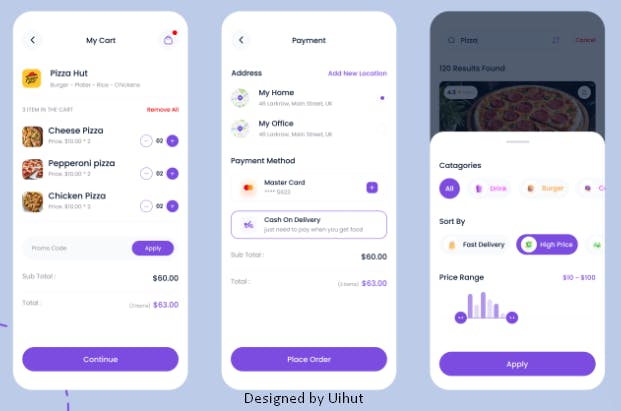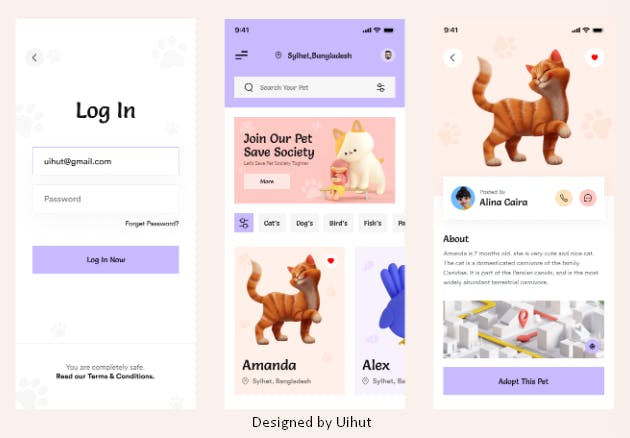A report by AppDynamics found that 60% of users uninstall an app after using it only once. So your mobile app design should be attractive, user-friendly, and enjoyable. A well-designed app with an excellent user experience can increase user retention and keep users coming back.
Everyone wants their app to be on top so the competition for mobile app design in the market is very high. If you want to be successful with your mobile app design, here are some pointers to keep in mind:
1. Define the app’s purpose and target audience
Every successful app begins with a solid strategy, and mobile app design is no exception. Determine what your app's purpose is, and what you want to achieve with your app. Create a design strategy and ensure that the app is in parallel with your business's goals, adds value, and increases conversion. This way, you can avoid wasting time and money designing a useless app
that does not provide value or meet your business goals.
Find out who your target audience is. Try to know what a targeted user actually wants from the app you are designing. What do they wish to achieve with your app? What requirements must they meet? What challenges and pain points do they face? Make sure the design of your app satisfies the needs of your users and solves problems.
2. Research market & competitors
Researching the market helps designers to understand the latest trends in the industry. Research similar types of other popular apps to see what makes them so popular. Even though there are other apps that are comparable to what you're designing that doesn't mean that yours won't be the one to beat them all. Collect useful design ideas from other apps and use them to brainstorm. Analyzing competitors' apps can help you figure out what they're offering their users. This data can be used to create a unique value proposition for the new app.
3. Master design elements

Before designing a mobile app, it is crucial to understand design elements such as color, typography, images, and other visual elements. These design elements help to establish the app's brand identity. Choosing the right color schemes and typography can make the app more attractive and functional. Decide which colors, fonts, and graphics match the story of your app.
4. Plan the user experience
The user experience is at the heart of good design.
A positive user experience is critical to the success of any mobile app. You can ensure that your app is designed with the user in mind by planning the UX. Understanding the user's needs, expectations, and pain points is part of this. You should design the user flow and user experience to be effective, enjoyable, and easy to use.
5. Make a great first impression
A great app is visually appealing, well-organized, and easy to use.
Create high-quality, eye-catching graphics to make your app stand out. It will make an excellent first impression.
Furthermore, rather than reading lengthy content, it is easier to understand graphics at first look. Nobody has time to read lengthy texts.
It saves users time, which is extremely important in today's world, where everyone has a lot to do in such a short period of time.
Also, use common design patterns that users are familiar with rather than forcing them to relearn basic actions. Users don't want to spend time figuring out how to use a new design pattern. It makes them relaxed and comfortable as they can complete tasks more quickly and easily.
6. Make it responsive
When designing your app, keep the user's device in mind. Because different devices have different screen sizes and resolutions, make sure your app is compatible and works properly on all of them. Frequently, the elements you include in your app UI design do not function properly. When you create elements that fit the screens of any device, you can ensure that users find it easy to complete tasks. This motivates them to spend more time on your app and provide more value.
7. Keep it simple
Users can easily understand a clean design. Many clients prefer a minimalist design because it helps them to complete multiple tasks with a simple UI and fewer steps. Keeping the design simple also helps users to focus and navigate your app with greater ease.
Make navigation simple. Navigation must be displayed at the top or somewhere else on the main screen to make it easy for users to access screens. To ensure smoother navigation from one screen to the next, you must collaborate closely with the app development team.
8. Organize properly

Proper organization and good placement elements make the app user-friendly. Use grids to quickly and simply specify margins and paddings. It helps to maintain balance in your design.
Consistency is a key principle of design. Consistency removes confusion. Keep the consistency of your app's color design, typography, and graphics. Also, it is important to consider the contrast between background and text colors, font sizes, and other design elements that may affect the readability of the app.
Nobody likes using a clumsy app. Every cluttered button, image, and icon complicates the screen. Cluttered design typically has a negative impact on users. Keep content and interface elements to a minimum. Also, mobile screens are small in size, so adding a large number of unnecessary elements in a small space is not good. Use white space. It gives a clean and uncluttered look to the app. This improves readability, decreases frustration, and provides a less stressful user experience. So, use white spaces to separate text, images, and other visual elements to make it easier for users to find what they're looking for.
9. Get User Feedback
The most important step is getting user feedback by involving them in testing them. Testing usability, functionality, and performance are essential. It helps to ensure that the app functions properly, is user-friendly, and satisfies the consumers. It also helps to find errors or bugs in the app before finally launched. So get feedback from real users and use the feedback to make changes and improve your app. Let users report errors, and make suggestions for improvements. Use surveys to know about the positive and negative sides of the app. Negative issues need to be solved.
10. Keep it updated
The design industry is ever-changing, with new trends, best practices, and techniques. As a designer, it is crucial to stay up to date with the latest trends, technology, and tools. Maintain compatibility with the most recent operating systems and devices for your app. Regular updates can help maintain the quality and relevance of your app to your users. Keeping an eye out for the latest trends ensures that your app is always updated and its performance is constantly improving. It delivers more value to clients.
Conclusion
The popularity of mobile apps is growing at an astonishing rate. This makes it crucial for designers to deliver high-quality designs.
While designing mobile apps, you should keep in mind that the success of a mobile app is greatly dependent on its design.
Hopefully, these mentioned 10 tips will help you design a successful mobile app.
Best of luck!



